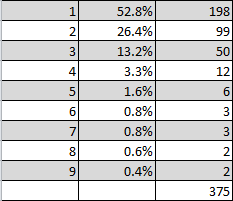Demographics and the military in my campaign, Part 1
Today, ladies and gentlemen, we'll be taking a long strange road to answer a simple question:
"How many troops can Duke Archanis Reynald field against the Bestials or some other invading army?"
It's been a crazy exploration of nuggets of information on population, the number of cities and towns, what affects the number of troops and just how many 5th level or above leveled NPC priests there are in this Duchy's army. None of this is particular new or earth-shattering or even original - I've culled the web and its resources to do all this. I've just put it all together in one place.
So... to answer that question, we start with a map:
Well, this one works, but I have to figure out how many hexes (Yea, YDIS, count-the-fuckin'-hexes, hardy har. No really... bear with me... ) so I did an exercise to come to an approximate count. I "squared up" the map as best I could in Hexographer, by removing/adding hexes until I had roughly a rectangle, turned on the grid numbering and looked in the lower right-most hex to get the total row/col count. 47,23. So the Duchy of Irecia is approximately 1081 hexes big.
Using my hex size of 20 miles (the distance an untrained person can walk in an 8 hour period, with rest) and the math found at S. John Ross's "Medieval Demographics Made Easy" page, I figured out that the total square miles for the Duchy is 374,469 miles².
Using *those* values, I went to the Welsh Piper "Medieval Demographics Online" tool and plugged in the values. I set my population density to 20. Normally, this would be 40/Adequate to 60/Ample for arable land/population density. , As this is post apocalyptic fantasy and a good third of Irecia is overrun by the Bestials, this value "felt" right to me.
That gives me a total population value of 7,489,380.
Now.. all that to get a population, now how do I get military values from that?
Well, in digging around some sources, I found this lovely article by John Savage, "The Numberless Hordes: Keeping Your Fantasy Armies a Little Less Fantastic" and he gave me some things to think about.
Base Population: 7,489,380
Draft Pool (15% of population): 1,123,407
Lost to Disease (50% of draft pool) ... wait a minute.
I've got GODS on my side! I've got CLERICS! Cast spells and all that jazz! You know... HEALERS!
But... do I have enough 5th level and above healers to make a difference? Well... so that takes me to a *different* breakdown, one that Daniel over at Delta's D&D Hotspot did on level distributions and demographics in OD&D. Using his logic, I came up with the average breakdown and percentage of distribution across a population of leveled persons.
So.. how many 5th level clerics within my army? Well, go back to S.J.R's Demographics page and there is this little tidbit: "Some other figures: There will be one noble household per 200 population, one lawyer ("advocate") per 650, one clergyman per 40 and one priest per 25-30 clergy." When I look at Welsh Piper's article "Low Fantasy Populations", he has a different ratio for clergy - 1 per 120. I like simple, so I go with 1/100.
If I assume that a "clergyman" is a level 0 flunky working for the Church, and a "priest" is a leveled NPC cleric type, then calculating for my draft pool from above:
Draft Pool (15% of population): 1,123,407
Clergymen (1 per 100 population): 11,234
Priests (assuming 1 per 30 clergy): 375
Applying the percentages of distribution for levels, I get:
So I have 16 priests/NPC clerics from levels 5 to 9 that can cast "Cure Disease." Calculating in the number of spells they get (on average) per day, that's 29 possible people cured of disease. Per day.
A drop in the 55 gallon drum for this million person army. So.... despite magic and clerical abilities, the sheer numbers rule. No magical curing of all disease. The 50% loss stands. Diversion aside, I go back to my numbers.
Base Population: 7,489,380
Draft Pool (15% of population): 1,123,407
Lost to Disease (50% of draft pool): 561,704
Other Requirements (40%): 224,682
Resulting Army: 337, 022
In John Savage's article, he says "Note: The precision and reliability of the source materials vary quite a bit; the "rounder" a percentage, the greater the variation." And in his table, he set "Other requirements" to 80% - including "Navy, Town Watch, Border Guards, Bodyguards, Camp Guards and Lack of Transport." That number felt a lot off to me, so I went back and forth and came to an assumption that 2 out 5 soldiers would be doing something else that kept them from marching and fighting.
So out of a population of almost 7.5 million people, at the end of the day, a total call-up would result in roughly 337,022 soldiers. Roughly 4.5% of the population.
That's enough for today, next time, The next step is to figure out how the knights, cavalry, archers and foot soldiers break out... and how many are leveled NPCs.




